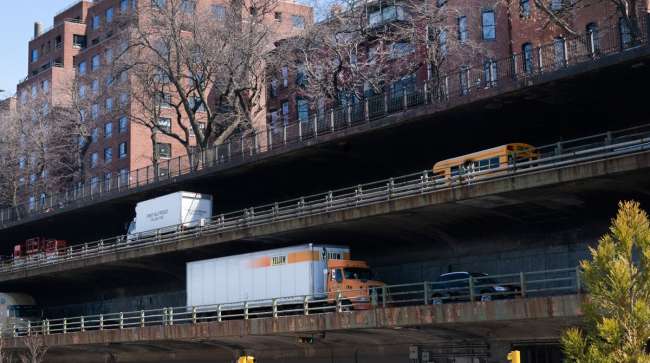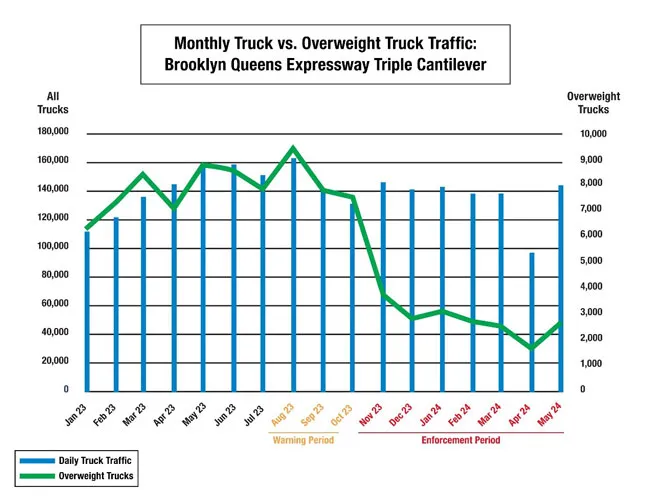Staff Reporter
NYC Smart Roads Deter Heavy Trucks on Aging BQE

[Stay on top of transportation news: Get TTNews in your inbox.]
New York City officials plan to launch an automated enforcement weigh-in-motion program for inbound Staten Island traffic this year after the technology dramatically deterred overweight trucks on the triple cantilever of the aging Brooklyn-Queens Expressway.
“Last year, we launched the nation’s first automated enforcement program to protect the Brooklyn-Queens Expressway from overweight vehicles — and it has yielded dramatic results,” said Ydanis Rodriguez, commissioner of the city’s Department of Transportation. “Thanks to cutting-edge roadway sensors, we have reduced the number of overweight vehicles on the BQE by 64%, reducing wear and tear on this critical infrastructure and extending its useful life.”
NYC DOT currently operates the WIM technology on the Queens-bound portion of the expressway in downtown Brooklyn along a section of Interstate 278 (BQE Central) to enforce state laws protecting the lifespan of roads and bridges. This roadway section, built in 1954 for commercial and passenger vehicles, is deteriorating and has structural challenges.
U.S. Rep. Dan Goldman (D) said, “This automated enforcement measure has improved road safety for the surrounding communities and commuters alike, providing more time to solicit community input for any future redesign of the structure.”

Goldman
During the first seven months of automated enforcement, a monthly average of 2,769 overweight trucks crossed the BQE’s triple cantilever, compared with a monthly average of 7,777 overweight trucks in the seven months before the system was deployed.
The percentage of overweight trucks has fallen from 6.3% there to 1.9% in recent months.
“Weigh-in-motion technology has successfully eliminated two out of three overweight trucks that had been illegally driving on the Queens-bound portion of the triple cantilever of the BQE,” said City Councilmember Lincoln Restler. “We hope to see a similar reduction on the Staten Island side when it is finally implemented, to help extend the lifespan of the triple cantilever structure.”
Restler led City Council efforts to support successful state legislation last year that authorized the WIM system.

Deputy Mayor Meera Joshi said New York City’s use of this technology in automated regulatory enforcement on the BQE “is leading the nation in efficiently and effectively keeping overweight trucks off the road through in-ground sensors on the BQE.”

Joshi
“This transformational technology protects and prolongs the lifespan of our critical infrastructure, like the triple cantilever portion of the BQE, and improves safety for all road users. We’re grateful to our legislative partners who enabled this impactful program and look forward to expanding its use in New York City.”
The city mandates that the WIM system undergo a five-calibration check every six months. This type of system relies on electronic sensors to measure various features of vehicles in motion.
Many state DOTs use WIM technology to gather weight data on highways for future infrastructure projects, as it avoids traffic congestion by allowing drivers to continue traveling without stopping at weigh stations.
Caltrans, for example, has used WIM systems since 1987 to collect data, not for enforcement or inspections. Data on overweight vehicles in California includes time and date, speed, vehicle axle counts, axle spacing, axle weight, gross vehicle weight, weight violations, vehicle classification and overall length.
Want more news? Listen to today's daily briefing above or go here for more info
The Federal Highway Administration’s Freight Management Operations says typical WIMS system hardware includes:
- A scale or set of sensors on the mainline or installed on a ramp to record a passing vehicle’s impact.
- A roadside cabinet with a processor that converts a passing vehicle’s downward force readings on the scale into data estimating gross weight and axle weights.
- A communication system transmitting weight data to computers of enforcement personnel or a WIM database management system.
Before deploying the technology for Staten Island-bound traffic at the end of this year, the public will receive a 90-day warning period before the system starts tracking overweight trucks.
In August 2023, public notices warned that the BQE’s new overweight-vehicle fining system would launch Nov. 8, 2023, with $650 fines per violation.
This section of I-278, the only interstate in Brooklyn connected to Manhattan, Staten Island and Queens, is a key freight route into New York City from New Jersey to the south through Staten Island and also for Nassau and Suffolk counties.
The National Institute of Standards and Technology (under the U.S. Department of Commerce) has been monitoring the use of the technology on BQE for violations as a legislative application of WIM systems for regulatory enforcement. NIST plans to include this scenario in an update to its 573-page NIST Handbook 44, issued November 2023, called “Specifications, Tolerances, and Other Technical Requirements for Weighing and Measuring Devices.”
Jeff Loftus of FMCSA joins TT’s Seth Clevenger to discuss the current outlook on ADAS technology and how it will affect the industry at large. Tune in above or by going to RoadSigns.ttnews.com.
NIST described the BQE project last April as being innovative.
“Vehicles that are liable to exceed the road weight limit are traditionally guided off the road to a location nearby and weighed on a static scale. This can be a dedicated weigh station or a location where the vehicle is weighed on portable wheel-load weighers,” NIST stated. “However, there are no suitable weigh stations near the troubled section of the BQE, and due to the dense construction in NYC, there is insufficient space to pull a truck over to weigh it on a portable scale.”
It added that New York officials decided to try the WIM system on BQE as an innovative regulatory enforcement measure to deter overweight vehicles while protecting the BQE’s structure.
“While urgent repairs are underway to protect this critical piece of infrastructure,” NIST stated, “additional means to slow down further deterioration needed to be identified.”





